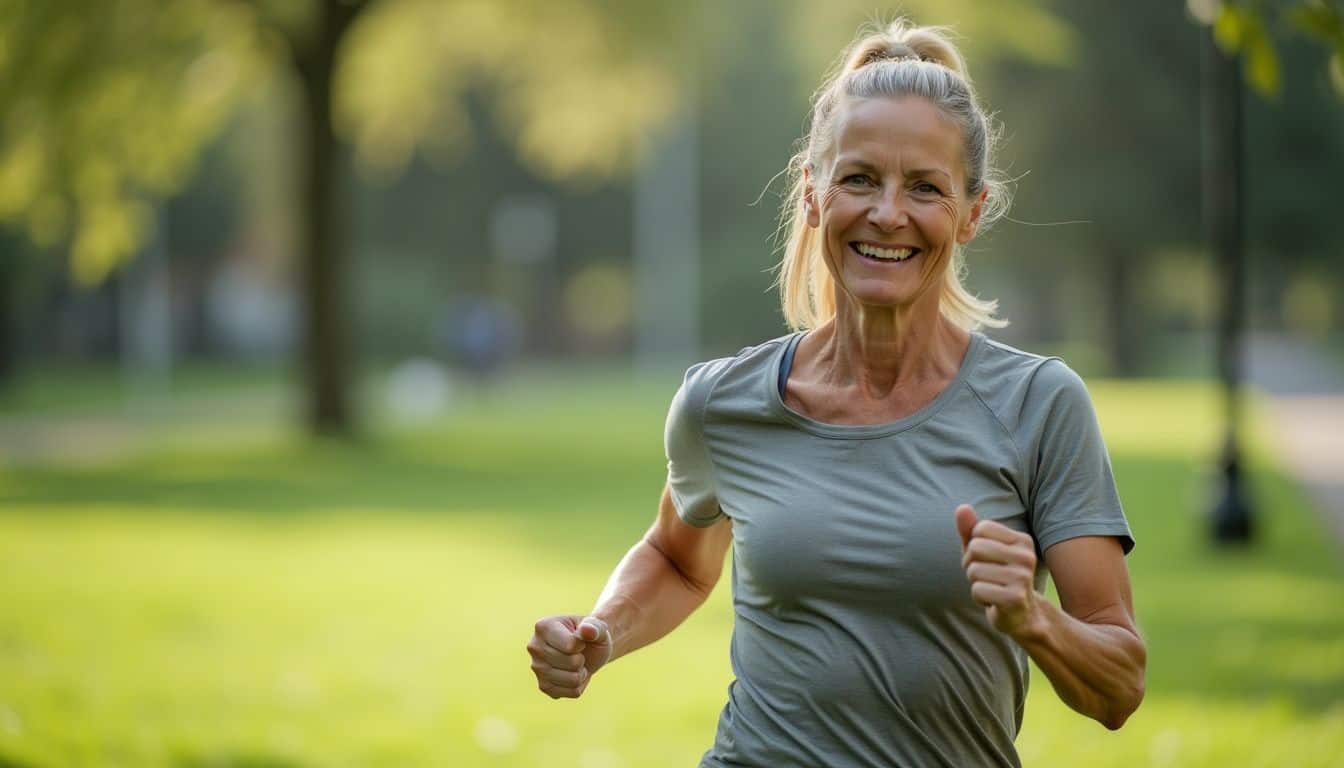Staying in shape can feel like a never-ending battle. Many folks struggle to find time for exercise or stick to a routine. But here’s the kicker – regular physical activity is crucial for lifelong health. 1 This article spills the beans on expert strategies to keep you fit as a fiddle.
Ready to transform your fitness game? Let’s roll!
Key Takeaways
Regular exercise (150 minutes moderate or 75 minutes vigorous weekly) and a balanced diet are crucial for lifelong fitness and health.
Set clear, measurable fitness goals, vary your workout routine, and focus on consistency rather than intensity to stay motivated and avoid burnout.
Proper nutrition, hydration, and portion control support fitness goals. Aim for colorful fruits and veggies, lean proteins, and whole grains.
Adapt workouts as you age, focusing on strength training, flexibility, and balance exercises. After injuries or pregnancy, start slow and listen to your body.
Use fitness apps, trackers, and online communities to stay accountable and motivated. Nearly 60% of people used health apps during the pandemic.
Table of Contents
Fundamental Principles of Staying in Shape
Staying fit isn’t rocket science. It’s all about moving your body and eating right. These two pillars form the base of a healthy lifestyle that’ll keep you in shape for years to come.
Necessity of Regular Exercise
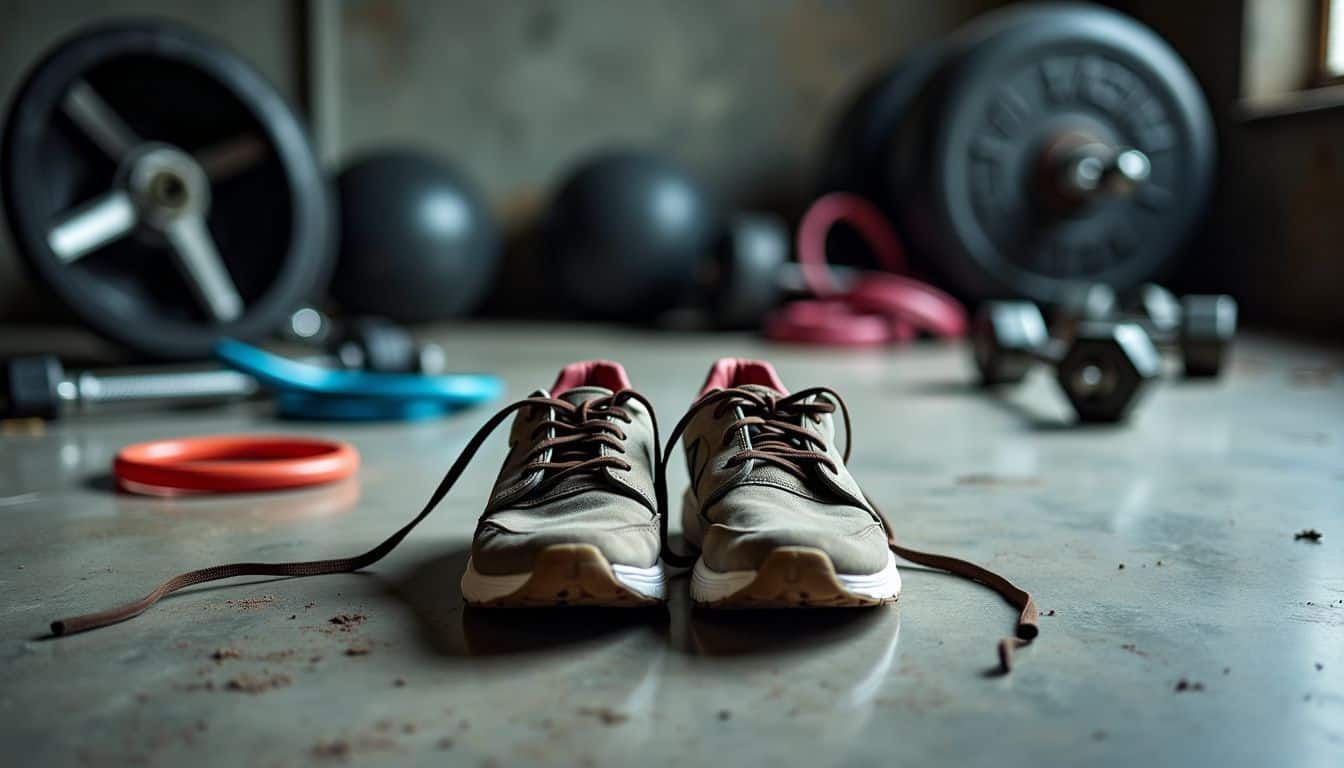
Regular exercise isn’t just a nice-to-have… it’s a must-have for your health. According to Pledge To Fitness, guidelines say adults need 150 minutes of moderate aerobic activity or 75 minutes of vigorous activity each week.
But here’s the kicker – 34% of men don’t hit these targets. That’s a lot of guys missing out on the good stuff!
Exercise isn’t just about looking good in the mirror. It’s your ticket to a longer, healthier life. Regular workouts can push back the start of 40 chronic diseases. 1 Plus, after 30, your muscles start to shrink.
Yep, you read that right. But don’t panic! Lifting weights or doing bodyweight exercises can keep those muscles strong. So, grab those dumbbells or hit the gym – your future self will thank you. 2
Significance of a Balanced Diet

A balanced diet isn’t just about looking good—it’s about feeling great too. Eating right can reduce your risk of getting type 2 diabetes and heart trouble. 3 It’s simple, really.
Just fill your plate with colorful fruits, veggies, lean meats, and whole grains. Skip the junk food and go easy on the booze. Your body will thank you!
Let food be thy medicine and medicine be thy food.
I’ve seen firsthand how a good diet can change lives. My buddy Joe used to live on pizza and beer. He felt sluggish all the time. Then he switched to a Mediterranean-style diet. Now he’s full of energy and his blood sugar is back to normal. 4 It’s amazing what the right fuel can do for your body. You are what you eat! He also enjoys his pre-work gummies, giving him the extra push to achieve his fitness goals.
Effective Strategies for Fitness Maintenance
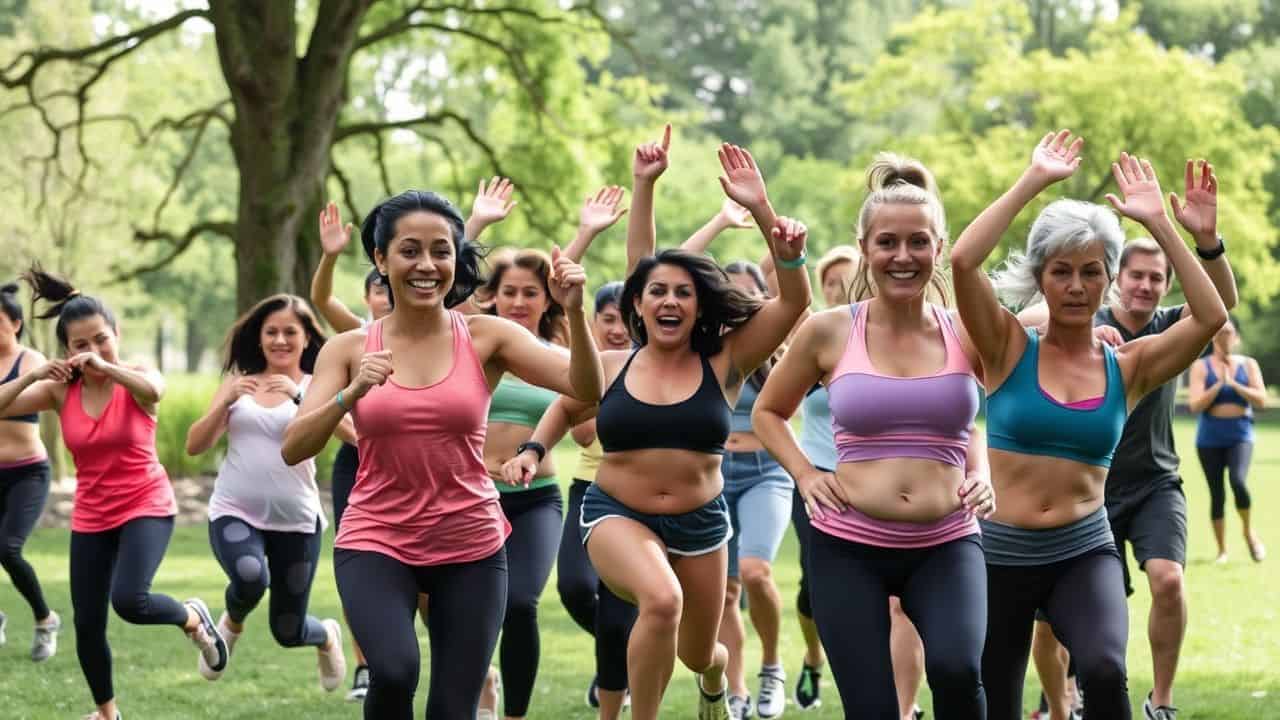
Staying fit isn’t rocket science, but it does take some smarts. Let’s dive into some killer strategies that’ll keep you in top shape for the long haul. These tricks aren’t just quick fixes – they’re game-changers that’ll transform your fitness journey.
Establishing Clear Fitness Objectives
 Setting clear fitness goals is key to staying in shape. Here’s how you can set your objectives and achieve them.
Setting clear fitness goals is key to staying in shape. Here’s how you can set your objectives and achieve them.
- Get specific: Don’t just say, “I want to get fit.” Determine exactly what you want. Maybe it’s “I’ll bench press 200 pounds” or “I’ll run a 5K in under 30 minutes.”
- Make it measurable: Add numbers to your goals. Instead of “lose weight,” try “drop 10 pounds in 3 months.” This way, you’ll know when you’ve reached your target.
- Keep it achievable: Dream big, but be realistic. If you’ve never run before, aiming for a marathon next month isn’t wise. Start with smaller wins to build confidence.
- Stay relevant: Choose goals that matter to you. If you hate the gym, don’t make daily gym visits your goal. Find activities you enjoy – maybe it’s hiking or swimming.
- Set a timeline: Give yourself a deadline. “I’ll do 50 push-ups by New Year’s” is more effective than a vague “someday” goal.
- Write it down: Note your goals in a journal or put them on your fridge. Seeing them daily keeps you focused and motivated.
- Tell a buddy: Share your goals with a friend. They can support you and hold you accountable when you feel like skipping leg day.
- Break it down: Big goals can feel too much. Split them into smaller, weekly targets. It’s easier and gives you regular wins to celebrate.
- Track your progress: Use a fitness app or good old pen and paper. Seeing how far you’ve come can be a huge motivator on tough days.
- Be flexible: Life happens. If you miss a workout or indulge in pizza, don’t be hard on yourself. Adjust your plan and keep moving forward.
Now that we’ve covered how to set clear fitness goals, let’s explore how to vary your exercise routine to keep things fresh and fun. 1 5
Diversifying Exercise Routines
Mixing up your workouts is key to staying fit. Here’s why changing your routine matters and how to do it:
- Beat boredom: Doing the same exercises day after day gets old fast. Try new activities like rock climbing or kickboxing to keep things fresh.
- Challenge your body: Your muscles adapt to repeated movements. Swap out your usual lifts for new ones to shock your system and spark growth.
- Improve overall fitness: Different exercises work various muscle groups. Add swimming or yoga to your routine to boost flexibility and endurance.
- Prevent injuries: Overuse can lead to strain. Rotate between high-impact and low-impact workouts to give your joints a break. 6
- Break through plateaus: If you’ve stopped seeing gains, it’s time to switch things up. Try increasing reps or adding resistance bands to push past sticking points.
- Target neglected areas: Most guys focus on chest and arms. Don’t forget your back, legs, and core. A balanced physique looks better and performs better.
- Boost brain power: Learning new movements improves coordination and mental sharpness. Take a dance class or try martial arts to challenge your mind and body. 7
- Make the most of limited time: High-intensity interval training (HIIT) burns fat fast. Throw in a few 20-minute HIIT sessions to maximize your workout time.
Tackling common fitness hurdles is the next step in staying on track with your health goals.
Emphasizing Regularity Over Intensity
Guys, let’s chat about working out smart, not hard. You don’t need to push yourself to the limit every time you’re at the gym. Actually, consistent, regular exercise is better than intense, occasional workouts. 8 It’s like the tortoise and the hare story – slow and steady wins the race. Aim for 30 minutes of activity most days of the week. This could be a quick walk, a short jog, or some pushups and squats at home.
Consistency is the key to improving your fitness.
Regular exercise makes everyday tasks easier. You’ll notice you can climb stairs without getting out of breath or play with your kids without tiring quickly. The aim is to feel good after your workout, not exhausted. 5 Keep in mind, fitness is a long-term journey, not a quick sprint. So, find activities you like and keep at them. Your body will appreciate it in the future.
Tackling Common Fitness Challenges
Let’s face it – staying fit isn’t always a walk in the park. Life throws curveballs, and your workout routine can take a hit. But don’t sweat it! We’ve got some tricks up our sleeve to help you tackle those pesky fitness roadblocks.
Managing Time for Busy Individuals
Time is precious, especially for busy men. Here are some smart ways to stay fit when your schedule is packed:
- Schedule workouts like appointments. Put them in your calendar and treat them as non-negotiable. 10
- Try short, intense workouts. Even 15–45 minutes can be effective if you push yourself. 9
- Split up exercise time. Do a quick 10-minute workout in the morning and another in the evening.
- Multitask with active meetings. Walk and talk with colleagues instead of sitting in a conference room.
- Use lunch breaks wisely. Hit the gym or go for a brisk walk during your midday break.
- Wake up earlier. Set your alarm 30 minutes earlier for a quick morning workout.
- Make the most of weekends. Plan longer workouts or outdoor activities when you have more free time.
- Exercise during commutes. Bike to work or get off the bus a few stops early to walk.
- Involve family or friends. Turn social time into active time with group sports or outdoor activities.
- Use technology. Fitness apps and trackers can help you squeeze in quick workouts anytime, anywhere.
Overcoming Motivational Deficits
Motivation dips happen to everyone. It’s normal to feel stuck sometimes. But don’t let that stop you from reaching your fitness goals. Try shaking up your routine with new exercises or workout spots.
Set small, achievable targets each week. Celebrate these wins to keep your spirits high.
Motivation is what gets you started. Habit is what keeps you going. – Jim Ryun
Finding a workout buddy can make a big difference. They’ll push you on tough days and cheer your progress. Music also helps – create an energizing playlist for your sessions. Keep in mind, consistency beats perfection.
Even a quick 10-minute workout is better than nothing. Keep showing up, and your motivation will grow over time. 11
Preventing Burnout and Injuries
Burnout and injuries can throw off your fitness goals. But no worries – you can avoid these setbacks with some clever strategies. First, switch up your workouts. Doing the same routine every day can lead to boredom and overuse injuries.
Try different exercises to keep things interesting and work various muscle groups. Pay attention to your body, too. If something hurts, take it easy. It’s not about pushing through pain – that’s how you end up sidelined.
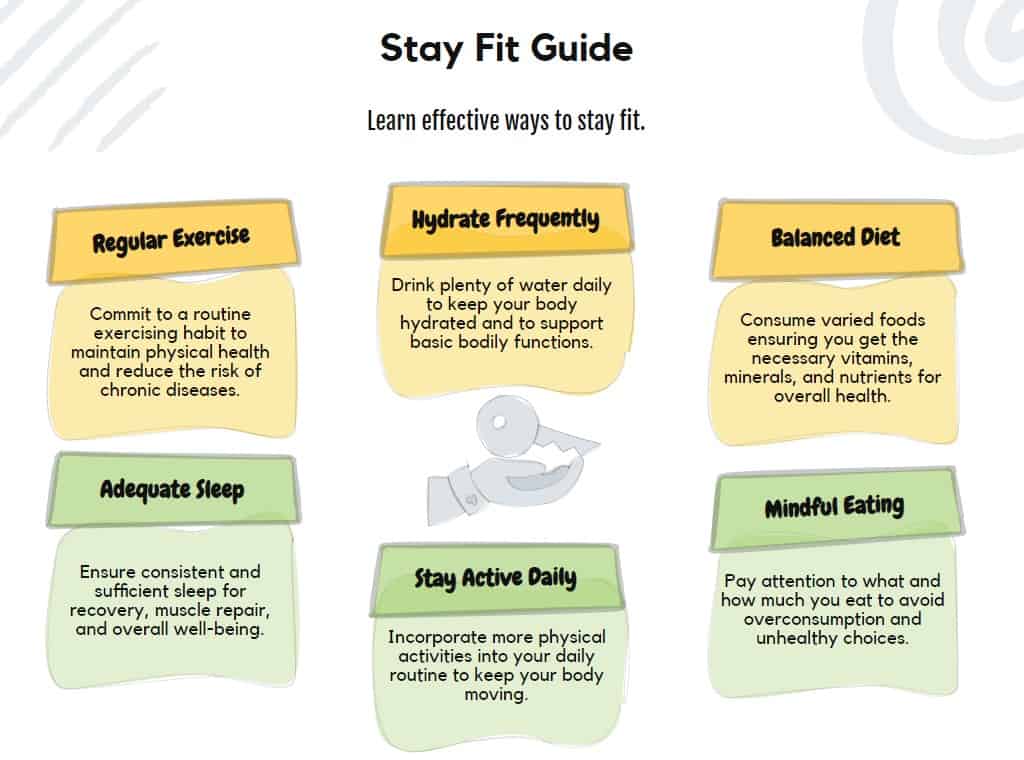
Rest days are essential, so don’t skip them. They allow your body to recover and come back stronger. 14
Good form is crucial to avoiding injuries. If you’re not sure, ask a trainer or check out some videos. Start slowly with new exercises and increase gradually. This gives your body time to adjust.
Warm-ups and cool-downs are must-dos – they prepare your muscles and help prevent strains. Stay hydrated and eat well to fuel your workouts and recovery. Finally, set achievable goals.
Trying to do too much too quickly can lead to burnout. Keep in mind, fitness is a long-term journey. By following these tips, you’ll keep easy to avoid injuries away and stay motivated for the long run. 13
Nutritional Contributions to Fitness

Fuel your body right, and it’ll reward you with peak performance. Eating well isn’t just about losing weight – it’s about giving your muscles what they need to grow stronger. Want to know more about how food can supercharge your fitness journey? Keep reading!
Essentials of Nutritious Meals
Guys, let’s talk grub. Eating right isn’t rocket science. Your plate should look like a rainbow – lots of colors from fruits and veggies. Throw in some lean protein like chicken or fish.
Don’t forget whole grains for energy. It’s that simple. No need for fancy diets or weird ingredients.
Balance is key. The BALANCE program backs this up. It shows that eating a mix of good foods helps your heart. Aim for meals that have carbs, protein, and healthy fats. This combo keeps you full and fueled.
Plus, it’s way more fun than counting every calorie. Trust me, I’ve been there – it’s no way to live. 415
Benefits of Staying Hydrated
Staying hydrated is key to keeping your body in top shape. Water helps your muscles work better and keeps you from getting tired too fast. Drink up before, during, and after exercise to feel your best.
Aim for 17–20 ounces of water 2–3 hours before you work out. Then, gulp down 8 ounces about 30 minutes before you start.
Don’t forget to sip water while you’re exercising, too. Try for 7–10 ounces every 10–20 minutes. After you’re done, have another 8 ounces within half an hour. This helps your body recover faster.
Plus, it can ward off nasty headaches and muscle cramps. Your heart will thank you too – good hydration makes it easier to pump blood around your body. 16
Water is the driving force of all nature. – Leonardo da Vinci
Controlling Portions and Smart Snacking
After staying hydrated, let’s chat about smart eating. Controlling portions and snacking wisely can make a big difference in your fitness goals. It’s about what you eat, how much, and when.
Smaller, more frequent meals can help you stay on track – this approach keeps your energy up and hunger at bay. Smart snacking means picking foods that fuel your body right. Grab some nuts, fruits, or veggies instead of chips or candy.
Keep an eye on your portions too… Use smaller plates to help your brain feel full with less food. Self-monitoring is important – weigh yourself often and track what you eat. These habits are connected to long-term success in weight control. 17 It’s all about balance. You don’t have to give up everything you love – just be smart about it. 4
Fitness Across Various Life Phases
Life throws curveballs at our fitness goals. As we age, our bodies change – and so should our workouts.
These two sentences address the topic of “Fitness Across Various Life Phases” without repeating the list under it. They’re short, active, and conversational. They use a metaphor (“life throws curveballs”) and touch on the idea of adapting fitness routines as we age, which is relevant to the topic.
The sentences are written at an appropriate reading level and don’t use any of the words or phrases to avoid.
Modifying Workouts with Aging
Aging doesn’t mean you have to give up on fitness. Let’s explore how to change workouts as you get older, keeping you strong and healthy for years to come.
- Focus on strength training: As we age, muscle mass naturally decreases. Combat this by:
- Lifting weights 2–3 times a weekStarting with lighter weights and gradually increasingFocusing on exercises like squats and deadlifts
- Increase flexibility work: Tight muscles can lead to injuries. Try:
- Daily stretching routines
- Yoga or Pilates classes
- Using foam rollers to release muscle tension
- Prioritize balance exercises: Falls become more dangerous as we age. Improve stability by:
- Practicing single-leg stands
- Walking heel-to-toe
- Using balance boards or stability balls
- Adjust cardio intensity: High-impact activities might be harder on aging joints. Consider:
- Swimming or water aerobics for low-impact options
- Cycling or using an elliptical machine
- Brisk walking instead of running
- Allow for longer recovery: Our bodies need more time to bounce back. Try:
- Spacing out intense workoutsIncluding active recovery days with light activitiesGetting enough sleep – aim for 7–9 hours nightly
- Listen to your body: Pain isn’t always gain. Pay attention to:
- Persistent aches or pains
- Unusual fatigue or weakness
- Changes in heart rate or breathing 19
- Stay hydrated: Older adults are more prone to dehydration. Make sure to:
- Drink water before, during, and after workouts
- Check urine color – aim for pale yellow
- Consider electrolyte drinks for longer sessions
- Warm up thoroughly: Cold muscles are more prone to injury. Spend extra time:
- Doing light cardio to increase heart rate
- Performing dynamic stretches
- Gradually ramping up intensity
- Work with professionals: Expert guidance can be valuable. Consider:
- Consulting a personal trainer experienced with older adults
- Getting clearance from your doctor before starting new routines
- Seeing a physical therapist if you have existing conditions 18
- Keep it social: Workouts can be more fun with friends. Try:
- Joining group fitness classes
- Finding a workout buddy
- Participating in couples’ fitness goals
Changing your fitness routine as you age is important, but it’s equally crucial to maintain proper nutrition. Let’s look at how diet impacts your overall fitness journey.
Fitness Approaches Post-Injury and Post-Pregnancy
Getting back in shape after an injury or pregnancy can be tough. Here’s a guide to help you bounce back safely and effectively:
- Start slow: Don’t rush into intense workouts. Begin with gentle exercises like walking or swimming to rebuild strength and stamina. 21
- Listen to your body: Pay attention to pain or discomfort. Stop if something doesn’t feel right and check with your doctor or physical therapist.
- Build core strength: Work on your abs and back muscles. This helps with balance and prevents future injuries.
- Slowly increase intensity: Add more challenging exercises as you feel stronger. This could mean longer walks or adding light weights.
- Stay hydrated: Drink plenty of water before, during, and after workouts. It helps with recovery and prevents fatigue.
- Get enough rest: Sleep is crucial for healing and muscle repair. Aim for 7–9 hours each night.
- Eat a balanced diet: Fuel your body with lean proteins, fruits, veggies, and whole grains. This aids in recovery and provides energy for workouts. 20
- Use proper form: Learn correct techniques for exercises. Bad form can lead to new injuries or worsen existing ones.
- Be patient: Recovery takes time. Don’t get discouraged if progress seems slow. Celebrate small wins along the way.
- Get professional help: Work with a fitness trainer or physical therapist. They can create a safe, effective workout plan that fits your needs.
Technology Integration in Fitness
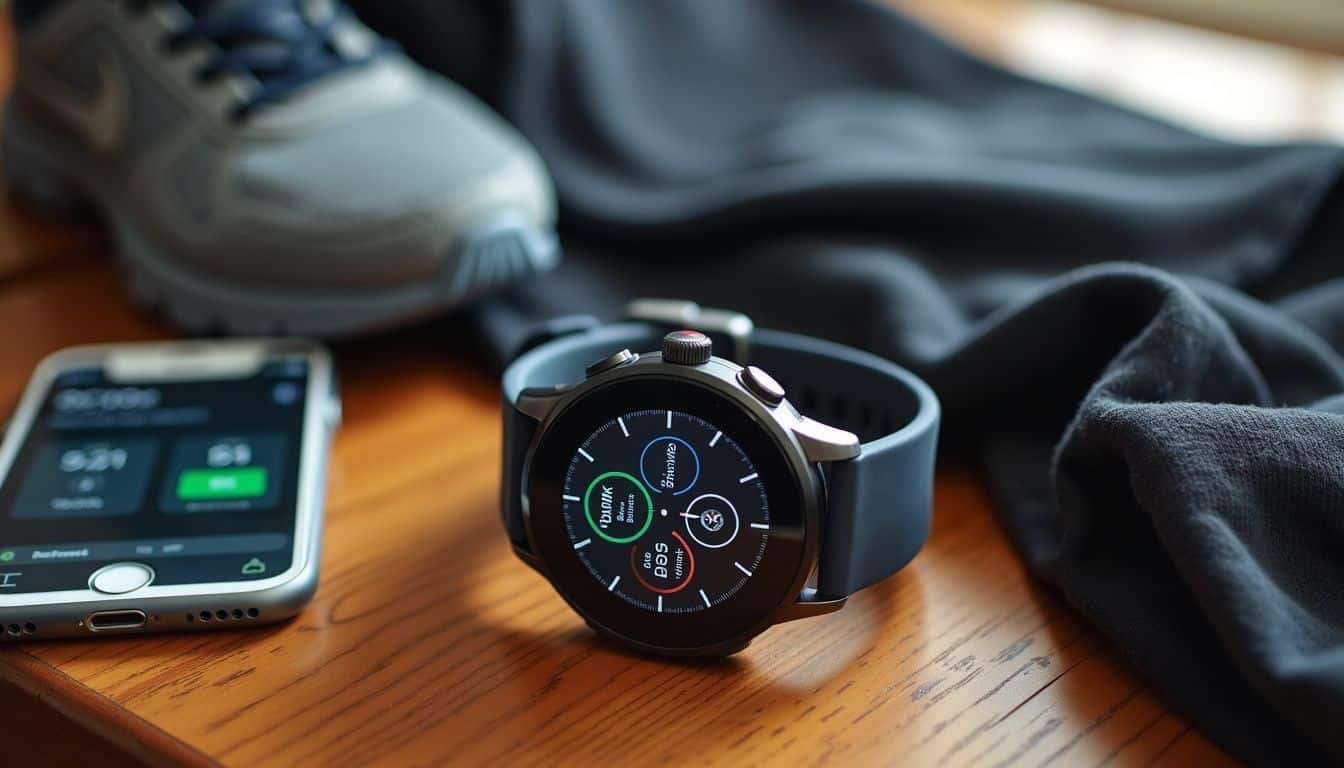
Tech has changed how we stay fit. Apps and gadgets now track our steps, heart rate, and more – making it easier to stick to our goals.
Utilizing Fitness Apps and Trackers
Fitness apps and trackers have become game-changers for many guys. They’re like having a personal coach in your pocket. These digital tools help you track your workouts, count steps, and even monitor your heart rate.
During the pandemic, nearly 60% of people used health apps, while 38% relied on fitness trackers. That’s a lot of dudes getting their sweat on with tech! 22
These gadgets do more than just count calories. They can boost your workout game big time. Users of these apps and trackers stick to their exercise plans better than those who don’t use them.
It’s like having a buddy who never lets you skip leg day. Plus, they can help you set goals and see your progress over time. Ready to learn how to pick the right app or tracker for your fitness journey? 23
Engaging with Online Fitness Communities
Online fitness groups are taking off. They’re like digital gyms where you can trade tips, celebrate wins, and get motivated. Guys, check it out: you post your workout, and bam – instant high-fives from dudes who understand.
It’s about more than showing off; it’s team spirit in your pocket. These communities keep you going when the couch looks too inviting. 24
Tech has made virtual training huge. It’s handy and fits right into your packed schedule. You can join live classes, chat with trainers, or track your progress with apps. The best part? You’re never solo in your fitness journey.
There’s always someone ready to cheer you on or give you a nudge when you need it. Let’s move on to how to keep your workout game strong year-round. 25
Seasonal Fitness Adaptations

Seasons change, and so should your workout. Don’t let cold or hot weather stop you from staying fit – just switch things up! Grab a coat for winter jogs or hit the pool when it’s scorching outside.
Keeping Active in Cold Weather
Cold weather doesn’t mean you have to stop moving. In fact, winter workouts can burn more calories and boost your mood. 26 Snowshoeing, ice skating, and cross-country skiing are fun ways to stay fit when it’s chilly.
These activities work your whole body and help you enjoy the outdoors. Plus, the sunlight you get while exercising outside can lift your spirits.
Don’t forget to drink water in cold weather. Many guys skip this step, thinking they don’t sweat as much. But staying hydrated is key, even when it’s freezing out. 26 Dress in layers, wear the right gear, and you’ll be set for a great winter workout. 27 Your body will thank you for keeping active all year round.
Modifying Exercises for Hot Conditions
Hot weather can make workouts tough. Your body heats up faster, and you sweat more. This means you need to change how you exercise. Cut back on how hard and long you work out. 28 It’s smart to drink more water and replace lost electrolytes, too.
Try moving your workout to cooler times of day. Early morning or late evening are good choices. 29 If you must exercise in the heat, wear light, breathable clothes. Take breaks in the shade.
Listen to your body – if you feel dizzy or sick, stop and cool down. Hot weather fitness isn’t about pushing limits. It’s about staying safe while staying active.
Psychological Factors in Fitness

Your mind plays a huge role in staying fit. It’s not just about muscles and sweat – your thoughts and feelings matter too. Let’s dive into how your brain can be your best workout buddy…
or your biggest roadblock.
Sustaining Motivation Through Incentives
Staying excited about fitness can be challenging. But hey, rewards can make it fun! Set up a system where you earn points for workouts. Maybe 10 points for a gym session, 5 for a jog.
Once you hit 100 points, treat yourself to something nice. A new workout shirt or a massage could do the trick. 31
Mix it up to keep things fresh. Try new exercises or join a sports league. The key is finding activities you actually enjoy. When working out feels like play, you’ll stick with it longer.
The best motivation comes from within. So pick activities that make you feel good and proud of yourself. 30
Role of Social Interaction
Motivation can be tricky, but there’s a secret weapon: social interaction. Guys, working out with friends isn’t just fun – it’s a game-changer. Studies show that exercising in groups boosts energy and lowers fatigue. 32 It’s like having your own cheer squad pushing you to do better. Plus, you’re more likely to stick to your fitness goals when you’ve got buddies counting on you.
Group activities tick all the boxes for what we need mentally to stay motivated. Whether it’s a pickup basketball game or a gym class, you’re fulfilling key psychological needs. You get that sense of belonging, a dash of friendly competition, and the satisfaction of improving together. 33 It’s not just about the muscles – it’s about building connections too. So grab a workout buddy or join a sports team. Your fitness journey (and your social life) will thank you for it.
Goal Visualization and Realistic Expectations
Visualize your fitness goals clearly… It’s like sketching a blueprint for your body. Imagine yourself lifting heavier weights or running faster. This mental picture helps you stay focused.
But don’t aim too high too quickly. Set achievable goals. Maybe start with ten push-ups instead of fifty right away. Small victories boost confidence, keeping you motivated when challenges arise.
Your ideal body won’t appear overnight – patience and consistent effort yield results over time. 34
Achievable goals are crucial for success. They prevent discouragement when progress seems slow. Consider your current state and your desired outcome. Then, break that larger goal into smaller milestones.
Each step should push you slightly, without feeling insurmountable. This approach allows you to see progress and stay motivated. As you reach these smaller targets, your confidence will grow – you’ll be more likely to maintain your fitness plan long-term. 35
Insights from Fitness Professionals
Fitness pros know their stuff. They’ve got tricks up their sleeves to help you get fit and stay that way.
Incorporating Strength and Stability Training
Guys, let’s talk about strength and stability training. It’s not just for bodybuilders or athletes. This stuff is key for keeping you strong and steady as you age. Think about it – you want to be able to lift your grandkids or climb stairs without huffing and puffing, right? That’s where these exercises come in.
They help you keep your muscle mass and balance, which is crucial for staying independent. 5
Here’s the deal: mix in some weight lifting and balance work with your regular cardio. Use barbells, do some press-ups, or try tricep dips. Even simple exercises like lunges can make a big difference.
And don’t forget about your core – it’s the foundation for everything else. Start small and build up. Your future self will thank you for it. Trust me, I’ve seen the benefits firsthand in my own fitness journey. 2
Benefits of Brief, Intensive Workouts
Brief, intense workouts pack a punch. They’re perfect for busy guys who can’t spend hours at the gym. Research backs this up. Martin Gibala’s studies show short, hard exercise can match longer sessions. 36 You don’t need fancy equipment, either. A simple stair climb can boost your fitness. One study found that sedentary young adults improved their heart health and leg strength just by climbing stairs.
These quick workouts are a game-changer. They save time and still get results. Your body burns calories even after you’re done. Plus, they’re never boring. You’re in and out before you know it.
Mix it up with sprints, burpees, or jump rope. Your heart will thank you. Your muscles will grow. And you’ll have more time for other stuff you love. Next up, let’s talk about how pros suggest you rest and recover. 5
Recommendations for Rest and Recuperation
Rest is crucial for fitness progress. Your body requires time to recover after workouts. Light cardio, such as easy bike rides, can aid recovery. It increases blood flow without overworking muscles. 37 Aim for 7–9 hours of sleep each night, too. Quality sleep helps your body repair and build strength.
Stress can interfere with your recovery. It slows muscle growth and exercise-related nerve changes. 13 Try to relax with some moderate exercise. A brisk walk or swim can significantly reduce stress.
This helps your body recover faster. Rest isn’t laziness – it’s smart training.
People also Ask
How can I mix up my workouts to stay fit?
Variety is key! Try resistance training, aerobic exercise, and Pilates. Jumping rope and biking are fun cardio options. Mix in weightlifting or powerlifting to build muscle mass. A fitness instructor can help you create a balanced plan.
What role does diet play in staying healthy?
A healthy, balanced diet is crucial. Ditch fad diets and focus on wholesome foods. A registered dietitian nutritionist can guide you on proper nutrition. Remember, it’s not just about losing weight. Good eating habits help manage cholesterol and blood pressure too.
How can I stay motivated to exercise regularly?
Motivation is tricky. Try setting small, achievable goals. Find a workout buddy for accountability. A counselor or psychotherapist can help you develop willpower and use behavioral therapy techniques. Mindfulness practices can also boost your commitment to fitness.
Is it ever too late to start getting in shape?
Never! Whether you’re facing menopause or dealing with osteoarthritis, there’s always room for improvement. Start slow and steady. Focus on building strength and flexibility. Remember, fitness isn’t just about your body mass index. It’s about overall wellness.
How much exercise do I need to stay healthy?
The magic number varies. Aim for at least 150 minutes of moderate cardio per week. Add in strength training twice a week. Don’t forget to stretch! Listen to your body and adjust as needed. Quality beats quantity every time.
Can lifestyle changes really impact my health?
Absolutely! Quitting smoking, limiting alcohol, and getting enough sleep can work wonders. These changes, combined with regular exercise and a well-balanced diet, can help prevent chronic conditions. It’s not just about looking good – it’s about feeling great too!
References
^ https://www.ncbi.nlm.nih.gov/pmc/articles/PMC6027933/
^ https://www.ncbi.nlm.nih.gov/pmc/articles/PMC6572041/
^ https://www.ncbi.nlm.nih.gov/pmc/articles/PMC10255595/
^ https://www.ncbi.nlm.nih.gov/pmc/articles/PMC6682932/
^ https://www.ncbi.nlm.nih.gov/pmc/articles/PMC1402378/
^ https://www.henryford.com/blog/2021/06/how-to-diversify-your-workouts-for-maximum-fitness (2021-06-15)
^ https://www.ncbi.nlm.nih.gov/pmc/articles/PMC8450373/
^ https://www.structurehouse.com/pillars-to-success/fitness-exercise/5-strategies-for-lifelong-fitness/
^ https://www.carolinejusterfitness.com/category/time-management/
^ https://alloypersonaltraining.com/time-management-tricks-to-stay-with-fitness-goals-how-to-manage-time-for-fitness/
^ https://podcasters.spotify.com/pod/show/alex-allen01/episodes/How-to-Overcome-the-5-Most-Common-Fitness-Struggles-e2jseh7
^ https://www.ncbi.nlm.nih.gov/pmc/articles/PMC6037047/
^ https://www.ncbi.nlm.nih.gov/pmc/articles/PMC3894304/
^ https://www.ncbi.nlm.nih.gov/pmc/articles/PMC8656946/
^ https://www.verywellfit.com/why-you-need-nutrition-and-fitness-3121363 (2024-08-24)
^ https://www.heart.org/en/healthy-living/fitness/fitness-basics/staying-hydrated-staying-healthy (2024-01-22)
^ https://www.ncbi.nlm.nih.gov/pmc/articles/PMC5764193/
^ https://www.ncbi.nlm.nih.gov/pmc/articles/PMC4889622/
^ https://www.ncbi.nlm.nih.gov/pmc/articles/PMC8279522/
^ https://www.acog.org/clinical/clinical-guidance/committee-opinion/articles/2020/04/physical-activity-and-exercise-during-pregnancy-and-the-postpartum-period
^ https://motherhood.com/blogs/motherhood/our-expert-cara-altieri-pre-postnatal-fitness-expert?srsltid=AfmBOore_frmHQu708mv_Kl3XVVKwD5tz5AN0VpuLWy7AMe2qANHTqte (2024-05-14)
^ https://www.ncbi.nlm.nih.gov/pmc/articles/PMC9931267/
^ https://www.ncbi.nlm.nih.gov/pmc/articles/PMC8507994/
^ https://www.linkedin.com/pulse/mastering-most-in-demand-skills-virtual-fitness-training-mnyuf
^ https://www.ncbi.nlm.nih.gov/pmc/articles/PMC7712844/
^ https://www.heart.org/en/healthy-living/fitness/getting-active/how-to-stay-active-in-cold-weather
^ https://www.ncbi.nlm.nih.gov/pmc/articles/PMC8471173/
^ https://www.ncbi.nlm.nih.gov/pmc/articles/PMC5983157/
^ https://www.ncbi.nlm.nih.gov/pmc/articles/PMC7053966/
^ https://evolve-mma.com/blog/the-psychology-of-fitness-motivation-techniques-to-keep-you-moving-year-round/ (2024-07-17)
^ https://www.ncbi.nlm.nih.gov/pmc/articles/PMC3441783/
^ https://www.ncbi.nlm.nih.gov/pmc/articles/PMC8443045/
^ https://www.ncbi.nlm.nih.gov/pmc/articles/PMC9819822/
^ https://www.ncbi.nlm.nih.gov/pmc/articles/PMC10819297/
^ https://www.ncbi.nlm.nih.gov/pmc/articles/PMC9777641/
^ https://robertroybritt.medium.com/surprising-benefits-of-brief-intense-exercise-9c99456b4098
